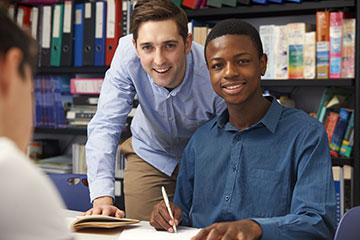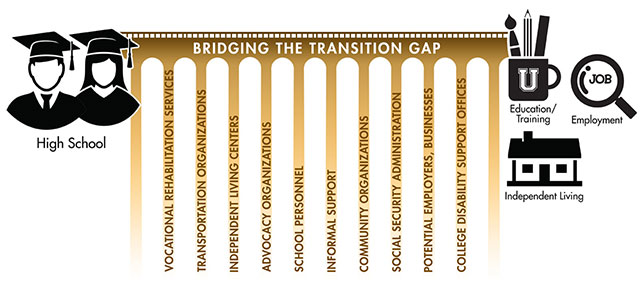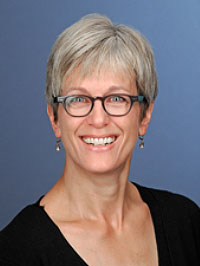How can school and agency personnel work together to support smooth transitions for these students?
Page 4: Interagency Collaboration

Recognizing that multiple individuals and agencies should be involved in transition planning is an important first step in addressing the transition needs of students with disabilities. Some of these can be met through informal supports (e.g., friends, peers), while others require formal supports (e.g., programs for people with disabilities). No one person or agency can meet the needs of all transitioning students; transition planning requires shared expertise and a wide range of services. These might include agencies that serve individuals with disabilities (e.g., vocational rehabilitation agencies) or those that serve all individuals (e.g., Social Security Administration). One role of the transition coordinator is to encourage representatives from outside agencies to participate in the transition planning process and interact with students, families, and others.
In the past, schools and agencies worked in isolation from each other, with the predictable result of uncoordinated services. In contrast, when agencies work collaboratively, they help create a bridge for students with disabilities from school to post-school activities and environments. Interagency collaboration is a process in which education professionals establish partnerships with personnel from multiple agencies to achieve a common goal: to improve the post-secondary success of students with disabilities. Interagency collaboration is a means to:
- Coordinate services and supports
- Identify and address gaps in services within the community
- Share and leverage resources to reduce costs
- Promote efficient service delivery

Listen as Mary Morningstar briefly defines interagency collaboration and who is typically involved in the process (time: 3:00).

Mary Morningstar, PhD
Associate Professor Special Education
Director of Transition Coalition
University of Kansas
Transcript: Mary Morningstar, PhD
Interagency collaboration takes on quite a lot of different definitions in terms of the big picture. In each school, the definition of interagency collaboration might look slightly different. But in general, it is a process whereby you carefully and purposely plan and design cross-agency, cross-program collaborative effort related to transition outcomes for youth. That’s a definition that’s been given within the research for what interagency collaboration means. Now, that certainly doesn’t assist school practitioners to take it to the level they need for implementation. Many teachers serve different types of students. So if you’re a teacher who’s serving students with learning disabilities, their post-school outcomes and therefore their support needs once they’re in the community and as adults are going to look different than teachers who are working with students with significant disabilities who may have long-term support needs. For those students and families, they would access different types of agencies and supports in the community.
So understanding how it operates in each community and for each teacher will look slightly different. But in general the process that would work for any teacher in any school district is first to identify the post-school outcomes, those measurable post-secondary goals that their students are interested in achieving, and then based on those outcomes to reach out and to go find the services and support that students would need in order to be successful in those post-secondary settings.
When we’re thinking about interagency collaboration, the critical groups that need to be involved certainly includes school personnel, whether that’s special ed teachers, transition coordinators, guidance counselors, school social workers. The folks that are engaged for all youth as they are exiting school and entering into their next phase, whether it’s post-secondary education or employment. That’s a critical piece of interagency collaboration. Families and students are also active and must be engaged in interagency collaboration themselves. They have very specific roles and responsibilities related to seeking out services and advocating for what they need from those service agencies.
And then the third and biggest, and that’s the group that’s most difficult to pin down. But those are those community organizations and agencies, both disability specific, for example vocational rehabilitation or agencies that are serving students with intellectual and developmental disabilities, mental health centers with some of the disabilities specific organizations. It can also include non-disability organizations. For example, an employment agency that’s serving anybody in the community, or tutoring at a community college that’s not specific to disability tutoring. So when we think about the group that have to be engaged it cuts across those three big groups, school, family, student, and then the community. It also cuts across disability specific organizations and those that anybody can access whether you have a disability or not.
Research Shows
- Interagency collaboration has been substantiated as a promising transition practice for several decades.
(Kohler, 1993; Landmark, Ju, & Zhang, 2010; Noonan, Morningstar, & Gaumer, 2008) - Interagency collaboration leads to more positive post-school outcomes, especially when students are linked with services prior to exiting high school.
(Test et al., 2009) - Building both formal and informal support networks during high-school using a person-centered approach has been shown to be associated with better post-school employment and education outcomes.
(Povenmire-Kirk et al., 2015)xperson-centered approach
A method of transition planning in which the student’s needs, strengths, and capacities determine the services he or she receives.
Interagency Teams
To create smooth transitions, it is important for school personnel and community representatives to work together to improve the post-secondary transition process and outcomes for students with disabilities. Doing so involves creating teams of people who meet with each other on issues related to these outcomes. These teams engage in interagency collaboration and might be organized at different levels (e.g., the school district, community, or state) and vary in number and how they divide responsibilities. These teams typically:
- Include representatives from disability-related organizations, community agencies, and workplaces all of whom understand the needs of the community as a whole and the needs of individuals with disabilities specifically.
- Share ideas, talents, and resources; determine how best to include students with disabilities in the community.
- Help to identify gaps in services within the community and solutions to bridge these gaps.
These teams and the work they do are always evolving. In addition, each state or community varies in how they are organized or structured. There can be and often is some overlap in team members. Below is one example of how interagency collaborative teams might be organized.
IEP/Transition Team
- Responsible for creating the individual student’s individualized transition plan (ITP)
- Members individually determined according to guidelines established by IDEA
- Additional members comprise the team based on the individual needs of the student
- Agency representatives providing direct services to the student may be a part of this team
- Ensures active participation from students and parents regarding transition planning informs the process
- Typically, works directly with student
School/Community Team
- Links education and adult service providers
- Involved in planning transition services at the community level (e.g., resource fairs)
- Include a wide range of professional representatives from community organizations, as well as family members and students with disabilities
- Typically, not directly involved with students
State Team
- Establish, evaluate, and revise policy
- Develop coordinated systems to reduce duplication, prevent gaps, and increase efficiency of services among agencies
- Evaluate the success of state and local transition services
- Leaders of public agencies (e.g., director of the Department of Health), legislators, parent representative, school representative, community rep (e.g., member of school/community team), representatives from disability organizations
- Typically, not direct service personnel
Mary Morningstar discusses a model of interagency collaboration that includes the IEP team and a community transition team. Next, she offers some tips for new teachers or those beginning the interagency process.

Mary Morningstar, PhD
Associate Professor Special Education
Director of Transition Coalition
University of Kansas
Transcript: Mary Morningstar, PhD (audio #1)
When we talk about the teams needed for transition, certainly the IEP team is the team that is most focused on the student. Oftentimes, if there isn’t a transition coordinator in a building, the teacher or the case manager for that student’s IEP often by default falls into that role of having to know about outside agencies. It’s written into the law that if students are already being served by an outside agency or it’s expected they would be served then the IEP case manager is responsible for inviting those outside agencies to attend the IEP meeting.
The role of beginning the process of collaboration for any special education teacher who’s involved with students during transition planning is important. But it really is focused on what’s going on with that particular student, and because it’s an IEP it’s really only during the period of time when the student is engaged in school in special ed services. When we think about models of interagency collaboration, the model that I’m most familiar with that is used most often around the country and across multiple states is a community transition team. That is where school personnel and all of the outside agencies might come together to start the planning process for collaboration. It may be at the district level if it’s a large district. It may be in a city or in a town. Or it could be at a county level or a regional level. This is particularly the case in more rural communities, where services are more spread out or they may only be offered in a regional location. Then you might have several districts joining a regional community transition team. But that is where you would bring all the outside agencies together. That’s often where they start to network, because they have to know about and learn about each other. And then once they know about and learn about each other they can start identifying where the barriers are in their community to successfully transition. And then they can identify some of those barriers, and then as a team they work together to solve and come up with solutions that are more at the systems level. So that will be beneficial to all the students coming through transition. So those are the teams that are most common when we talk about how you start planning for interagency collaboration.
Transcript: Mary Morningstar, PhD (audio #2)
Interagency collaboration can feel really overwhelming. I often think of it as the jet lag for schools and for new teachers in particular, because when you’re going through a teacher-education training program you are very focused on the skills you need to be successful with students. It’s all about student growth and student support. We don’t think about how teachers are engaged in facilitating the transition into adulthood. That’s not typically at the forefront of teacher preparation programs. So it can be sort of a shocking experience for teachers as they come into this field of secondary education and then the transition to adulthood.
It’s really not what you know about interagency in terms of all the different agencies. It’s about who you know that has the best, most current information. I would think any new teacher needs to find out from their district who is the one that’s responsible for putting together that comprehensive map or guidebook for transition, who knows about all those outside agencies. How can I then get information about those agencies and who at those agencies are my go-to person to ask questions? Even I cannot keep up with all the regulatory changes, new laws that impact those outside agencies. But I know my go-to people when I have questions. I can identify who I need to turn to. I think that’s probably a really critical first step for any novice teacher coming into a district, particularly at the secondary level. If their district says there isn’t anyone in our district that does it, and they’re passionate enough to want to create something, my experience is social workers know more about outside agencies than any one particular school personnel. So developing a district level team, be sure to include social workers and guidance counselors as part of that team would be a great way to start launching this process.
David Test describes the CIRCLES Project, an experimental model utilizing multiple levels of interagency collaboration to help assure smooth transitions for students with disabilities (time: 3:56).

David Test, PhD
Professor of Special Education
University of North Carolina
Transcript: David Test, PhD
The Circles Project itself is an interagency collaboration model. It is different than most interagency collaboration models. First, there are three teams. The first is the more traditional interagency collaboration team, and that is a district-level team. That team can meet three to four times a year. It’s made up of the bosses, the director of special ed, the director of VR, the director of mental health, the director of developmental disability services, people who can make changes to policies and procedures that need to be changed.
Many school systems have some sort of team like that community level team that meets a few times a year. What makes Circles different is the second level of team, which is the school-level team, and that team is made up of teachers, and VR counselors and case-managers, and people from the adult service agencies that would deal directly with students and families. Those meetings take place monthly. They can rotate across the school system. Different school systems do it different places. Some do it in different high schools each month, some do it at a central location, say a community college that is centrally located in their county, some do it at the education center if it’s easier for transportation. Those meetings usually take place over a day.
They’re made up of presentations by students. Usually, in a day you can get maybe ten students to come and present. The meeting starts with a review of what happened in the last meeting to make sure that students and families and the agencies connected as they were supposed to. When it’s time for the students to start, the students make a brief presentation, about five minutes, often with a PowerPoint. Sometimes they’ll use Voki or other Web 2.0 tools. It’s a presentation about what their strengths are, where they still think they need some support, and what they like to do after school in terms of employment and education and independent living.
Once they finish their presentation, they sit down at the table with all these representatives from different agencies. The people from the agencies talk to them about their services and what supports they may be able to offer them. Often, with a student comes at least one family member. Sometimes it’s moms, dads, aunts, uncles, grandparents, sometimes friends. So sometimes it’s an entourage, sometimes it’s not. But they’ll be part of this discussion. Then by the end of the meeting the student and their family leave the meeting with a to-do list. Here are the agencies that you should talk to or connect with for employment. Here are the ones if you’re interested in apartment living. So they’ve met the people, they’ve begun to talk about and know what services and supports are available for them once they leave high school.
So what the school system does with that information, they take that information back to the IEP team, which is the third team. That information can be put into the student’s IEP. The adult service people don’t have to come to the IEP meetings, since they’ve already signed off unless something changes. The adult service folks, typically, they’ll be invited to all these IEP meetings. They don’t have time to sit through that many meetings, and so by going to one meeting a month they can get the information they need for their services, but also that information can get into the IEPs for students. It’s a lot more time-efficient in terms of getting interagency collaboration. The Circles Project had been implemented in the Cleveland county schools in North Carolina for years and was very successful in terms of building interagency collaboration.